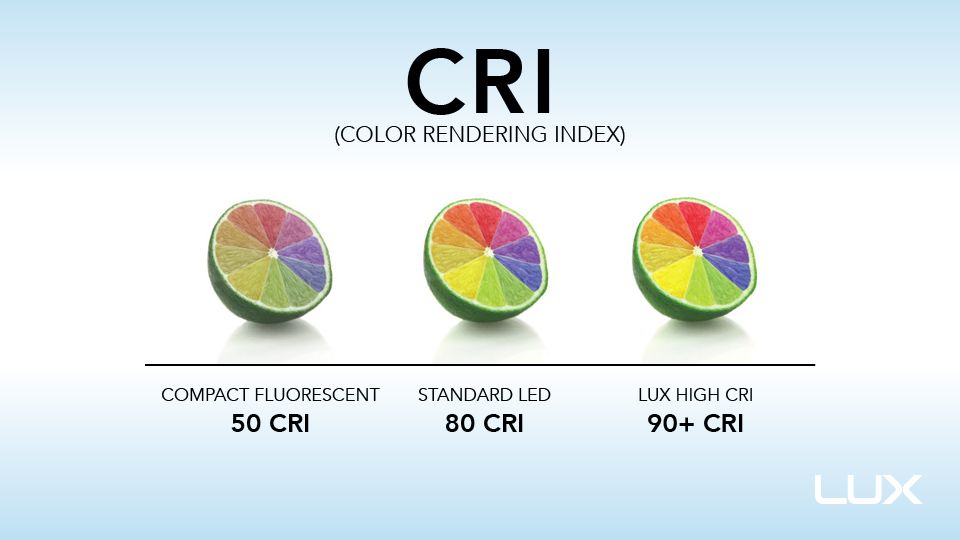Have you ever thought about the powerful impact lighting can have on the ambience in your barber shop? Choosing the right lighting might seem challenging, but its influence on your customer’s experience—and subsequently, your profits—is undeniable.
In the barber shop business, success hinges on the service you deliver and the client’s experience. Yet, many owners overlook a crucial aspect: lighting. The typical bright lights and vibrant colors can, ironically, cast unflattering shadows and create an undesirable atmosphere.
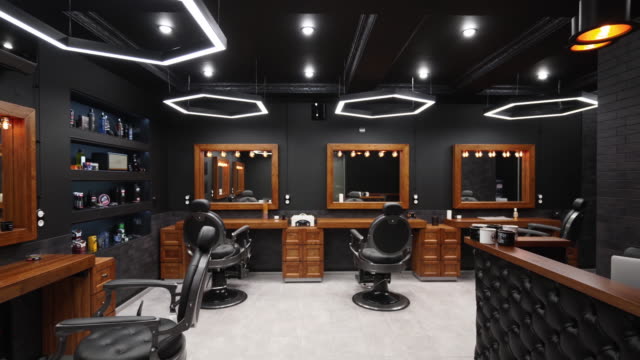
Let’s delve into the art of selecting the ideal lighting for your barber shop.
Importance of Right Lighting Design in Barber Shops
Imagine walking into a barber shop, and you’re instantly hit with a sense of unease. It’s either too dim to comfortably see or so brightly lit that you feel like you’re on a spotlight. Doesn’t sound too appealing, does it? Now imagine another scenario – you enter a barber shop with just the right balance of brightness and shadow, creating a space that’s inviting, comfortable, and exudes professionalism. It’s pretty clear which one you’d prefer, isn’t it? But why does lighting matter so much in a barber shop? Let’s delve into the specifics.
Proper lighting in a barber shop does more than just illuminate the space.
It sets the tone for the entire customer experience. An optimally lit barber shop enhances the precision of haircuts and grooming services, while also uplifting the aesthetic appeal of the space. It makes customers feel good about being in the shop, leading to a more enjoyable experience, positive reviews, and repeat business.
Proper lighting can also subtly emphasize the cleanliness of your shop, the quality of your services, and the range of products you offer, thereby fostering a sense of trust and professionalism. In a business where the goal is to help people look and feel their best, the importance of getting the lighting right cannot be overstated. In essence, proper lighting is instrumental in turning your shop from just another place for a quick trim into a memorable grooming destination.
Diving into the details of how to effectively illuminate your barber shop may seem overwhelming at first. But fear not, this comprehensive guide is designed to demystify the process and equip you with the essential knowledge and tips to master the art of lighting design in your barber shop. Let’s embark on this illuminating journey together.
Understanding Different Types of Lighting for Barber Shops
To achieve an optimal balance in your barber shop’s lighting, it’s essential to recognize the different types of lighting and understand how they can work together to create the ideal atmosphere.
Task Lighting: This is a focused type of lighting that’s critical in barber shops where precision is key. Task lighting illuminates specific areas where close and meticulous work, like cutting, styling, or shaving, is performed. Adjustable desk lamps or overhead track lights are common examples.
Ambient or General Lighting: This is the primary source of light in a barber shop, providing overall illumination. It’s typically soft and diffused, creating an inviting, comfortable atmosphere without harsh shadows. Examples include ceiling-mounted or recessed fixtures and wall sconces.
Accent Lighting: This type of lighting is used to highlight specific elements in the shop, such as product displays or artwork. It adds depth and dimension to the space, enhancing its aesthetic appeal. Picture lights, wall lights, or track lighting can serve as accent lighting.
Decorative Lighting: While not a primary source of illumination, decorative lighting contributes significantly to the shop’s style and atmosphere. It encompasses light fixtures like chandeliers, pendant lights, or vintage barber poles, which act as elements of decor while also providing light.
By skillfully combining these different types of lighting, you can create a well-lit barber shop that’s not only functional but also visually appealing and comfortable for both customers and staff.
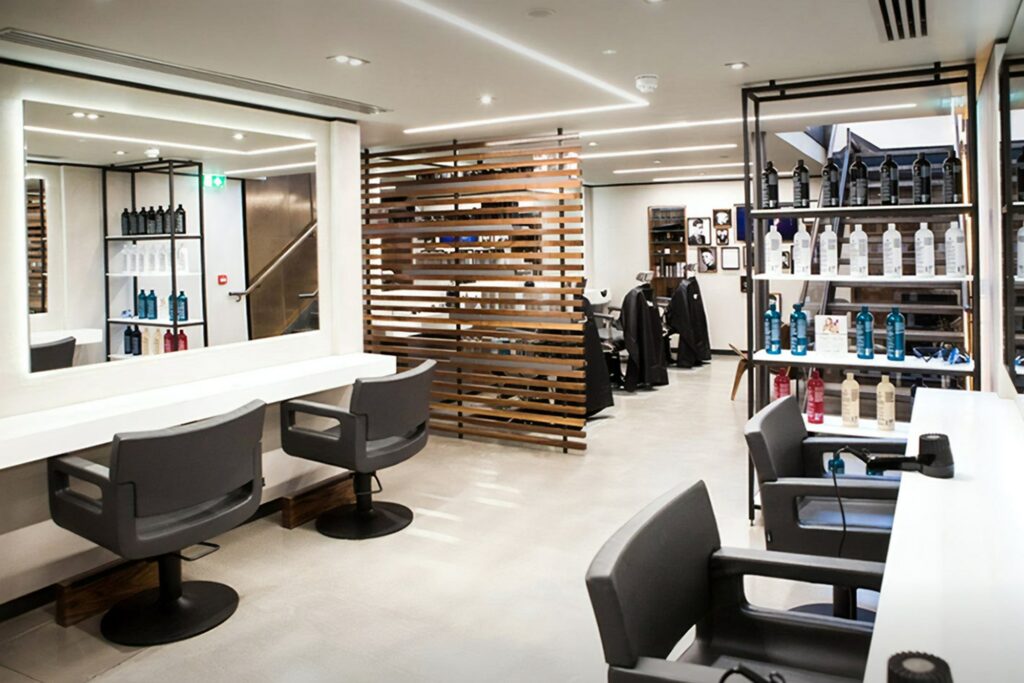
A Deep Dive into Lighting Fixtures: What Works Best in Barber Shops
Lighting fixtures are more than mere carriers of light bulbs – they are pivotal elements that define the character and functionality of your barber shop. Here’s a detailed look at the types of lighting fixtures that work best in barber shops:
Traditional Barbershop Lamps: This classic lighting option evokes a sense of nostalgia and vintage charm. With their distinctive globe-shaped bulbs and ornate detailing, traditional barbershop lamps add an air of authenticity and can be an attractive element in shops aiming for a retro vibe.
Modern Fixtures: Sleek, minimalist, and functional are the defining traits of modern lighting fixtures. They come in a variety of styles – pendant lights, recessed lights, track lights – and materials – metal, glass, acrylic. Modern fixtures can infuse a sense of contemporary sophistication into your shop.
Innovative Lighting Options – LED and Beyond LED lights have become increasingly popular owing to their energy efficiency, durability, and versatility in design. They are available in a plethora of colors, shapes, and sizes. Other innovative lighting options include smart lights that offer features like dimming, color changing, and app-based controls. These can create a dynamic and customizable lighting environment in your shop.
Spotlights: Spotlights, as their name suggests, focus a bright light onto a particular area or object. In a barber shop, spotlights can be strategically positioned for task lighting, helping barbers perform precise tasks. They can also serve as accent lighting, highlighting products or architectural features.
The choice of lighting fixtures depends largely on the design and theme of your barber shop, the specific lighting needs, and the atmosphere you wish to create. An optimal mix of different fixtures can result in a well-lit, aesthetically pleasing, and functionally efficient barber shop.
The Art of Positioning Lights in a Barber Shop
Lighting is a critical aspect in any setting, but in a barbershop, it’s particularly important. Correct positioning of lights not only helps the barber perform their work more effectively but also contributes to creating an inviting and relaxing atmosphere for customers. Here are some tips to consider for positioning lights in a barbershop.
- Task Lighting: Ensure that your barber’s chairs have appropriate task lighting. This is the most important area to illuminate since this is where precision work will be done. Spotlights, adjustable desk lamps, or pendant lights can be used to direct a bright light onto the customer’s head, ensuring that the barber can see their work clearly. Ideally, the light should be white to accurately show hair color.
- Ambient Lighting: In addition to the task lighting, you also need ambient lighting to set the mood of the shop. This can be accomplished through the use of ceiling fixtures or wall sconces that cast a soft and even light across the shop. The light should not be too harsh to avoid a clinical atmosphere.
- Mirror Lighting: Having good lighting around mirrors is essential. Consider using vertical fixtures or sconces mounted on either side of the mirror to provide even illumination, preventing shadows on the face which can impede the barber’s work.
- Accent Lighting: Use accent lights to highlight areas of interest, like product displays or art on the walls. This type of lighting adds depth and character to the space.
- Natural Light: If possible, incorporate natural light into your shop. Windows can bring in a pleasant, diffused light that adds warmth and helps to illuminate the shop in a pleasing way.
- Color Temperature: Generally, you should go for neutral or cool light temperatures (around 4000-5000K). Cooler light temperatures often provide the most accurate lighting for hair color and complexion, and are less likely to distort colors.
- Brightness: Ensure the brightness of the lights is just right, not too bright to be glaring or too dim to cause strain. Brightness between 75-100 foot-candles is often recommended for beauty salons and barbershops.
- Avoid Shadows: Position your lights in such a way that they don’t cast shadows, especially in the areas where barbers will be working. This often means placing multiple light sources in strategic locations.
- Safety: Position lights and cords safely to avoid tripping hazards or accidents.
Remember, the goal of your lighting should be to create a warm and inviting atmosphere for your customers while providing a well-lit and comfortable workspace for your barbers. Balancing aesthetics and functionality is key.
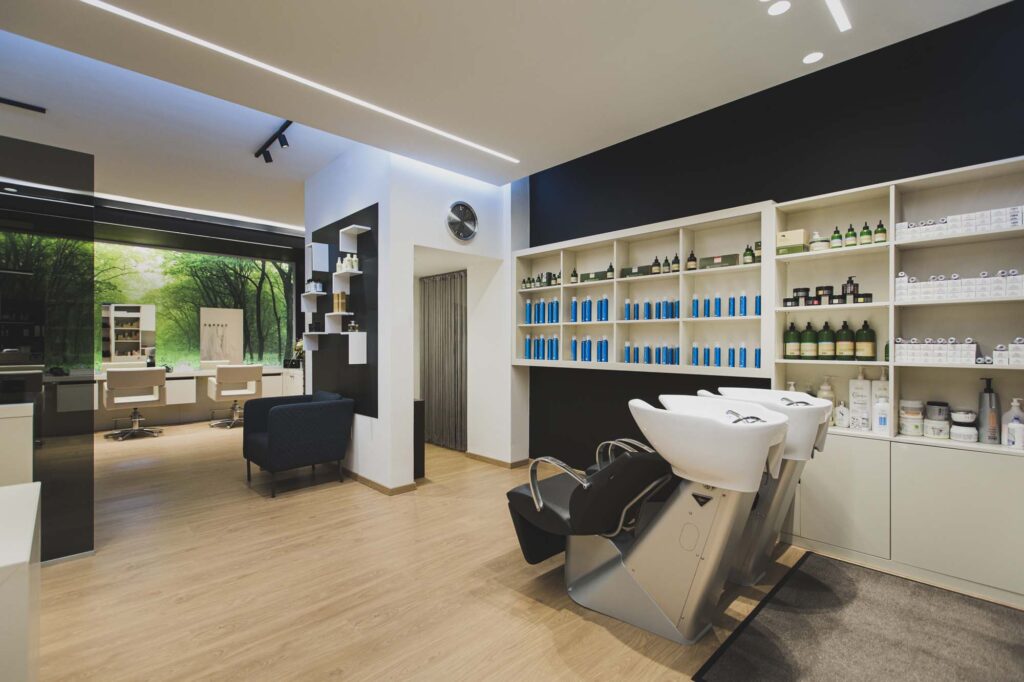
Importance of Brightness and Color Temperature in Barber Shop Lighting
The importance of brightness and color temperature in a barbershop setting cannot be overstated as they significantly influence both the comfort of customers and the precision of the barber’s work.
Selecting the Right Brightness Level: Comfort and Precision
- Precision: Brightness plays a crucial role in the barber’s ability to do their job effectively. The barber needs to clearly see the details of the hair and scalp to make precise cuts and trims. Inadequate lighting can lead to mistakes or uneven cuts, thereby affecting the overall quality of service.
- Comfort: While a brightly lit barber’s chair is important, the rest of the shop should also have sufficient lighting to ensure customer comfort and safety. However, the lighting shouldn’t be overly harsh as it could create an unpleasant experience for customers.
- Balance: Finding a balance between comfort and precision is key. A general rule is to aim for brightness levels between 75-100 foot-candles in the areas where barbers will be working. This level of light is generally considered bright enough for detailed tasks but not so bright as to be uncomfortable or glaring.
The Perfect Color Temperature: Warm vs. Cool Lighting
- Warm Lighting: Warm lighting (2500-3000K) creates a cozy and inviting atmosphere, which can make customers feel relaxed. However, it may not be suitable for task lighting as it can distort colors and make it difficult for the barber to accurately assess hair color and texture.
- Cool Lighting: Cool lighting (4000-5000K) offers a more accurate representation of hair color and texture, making it ideal for task lighting. It can also help to create a clean, professional look, but if it’s too cool, it can give the shop a clinical or stark feel.
- Balance: Balancing warm and cool lighting is important. It can be beneficial to use cool lighting for task lights over the barber chairs, and warm lighting for ambient lights to create a pleasant overall atmosphere.
In conclusion, when it comes to lighting in a barber shop, the goal should be to create a well-lit, comfortable environment that enables barbers to do their job effectively while also creating an enjoyable experience for customers. Considering both brightness and color temperature in your lighting design can help achieve this.
Energy Efficiency in Barber Shop Lighting
Energy efficiency is an essential factor to consider in any commercial lighting design, including in barber shops. Efficient lighting can significantly reduce energy consumption and associated costs, and also contributes to a more sustainable business practice.
How to Save Energy with Your Lighting Choices
- Switch to LEDs: LED lights are significantly more energy-efficient than traditional incandescent or fluorescent bulbs, and they also last longer, which means you’ll save on both energy and replacement costs.
- Lighting Controls: Implementing lighting controls such as dimmers, timers, or occupancy sensors can reduce energy usage by ensuring lights are only on when needed. For instance, occupancy sensors can automatically turn lights off when the shop or a particular area within it is unoccupied.
- Task Lighting: Using task lighting at each barber station allows you to provide bright light where it’s needed for detailed work, while keeping overall ambient lighting at a lower level. This can result in substantial energy savings.
- Natural Light: Utilize natural light wherever possible. Designing your shop to maximize daylight can reduce the need for artificial light during the day. However, consider heat and UV management to avoid discomfort or potential harm to products.
LEDs: A Sustainable Choice for Barber Shops
LEDs (Light Emitting Diodes) are a sustainable choice for barber shops for several reasons:
- Efficiency: LEDs use less power to provide the same amount of light compared to traditional lighting technologies. They convert most of the energy they consume into light, with very little wasted as heat.
- Longevity: LEDs have a longer lifespan, often lasting tens of thousands of hours. This reduces the frequency of replacement, reducing waste.
- Quality of Light: LEDs provide high-quality light and are available in a range of color temperatures, making them suitable for both task and ambient lighting.
- Dimmability: Many LEDs are dimmable, allowing you to adjust the light level to match the task or time of day, which can result in additional energy savings.
- Reduced Heat Output: LEDs emit very little heat compared to incandescent bulbs, reducing the burden on air conditioning systems and providing a more comfortable environment.
By implementing energy-efficient lighting solutions, barber shops can reduce their environmental footprint, save on energy costs, and even improve the comfort and quality of their services.
Lighting Regulations and Safety Considerations
Understanding Lighting Regulations for Commercial Spaces
Different regions have specific lighting regulations for commercial spaces.
Here are some general guidelines to consider, but it’s crucial to consult local regulations for precise and relevant information:
- Energy Efficiency: Many regions now have regulations that require commercial lighting to be energy efficient. This could include rules about using LED lights or other types of energy-efficient bulbs, as well as requirements for lighting control systems that reduce energy use when areas are not in use.
- Emergency Lighting: There are often strict requirements for emergency lighting in commercial spaces. This includes exit signs and lighting that will remain on or be triggered in the event of a power outage. These lights are crucial for guiding people to safety in an emergency.
- Task Lighting: Depending on the type of commercial space, there may be requirements for task lighting. For instance, in a barbershop, there may be specific rules about the amount of light needed (in foot-candles or lux) in the areas where barbers are working.
- Accessibility and Safety: Commercial spaces may need to comply with accessibility standards, such as those laid out in the Americans with Disabilities Act (ADA) in the U.S. This could impact lighting design, especially when it comes to avoiding glare or high contrast lighting situations that could be challenging for people with visual impairments. Safety regulations may also impact the types of lighting fixtures that can be used, or how they must be installed.
- Building Codes: Some local building codes have regulations for commercial lighting. This can involve requirements for energy conservation, safety measures like fire exits, the minimization of light pollution, and so on.
- Green Building Certifications: If you’re aiming for a green building certification, like LEED (Leadership in Energy and Environmental Design), there will be additional lighting regulations. These might relate to things like daylighting, energy use, lighting control systems, and the disposal of old lighting fixtures.
Prioritizing Safety in Your Lighting Choices
Lighting choices can significantly impact the safety of a space. Here are some key points:
- Avoid Glare: Glare can be uncomfortable and impair visibility, which could lead to accidents. Use diffusers or indirect lighting to avoid glare in your barbershop.
- Adequate Illumination: Ensure that all areas, including walkways and restrooms, are adequately lit. Poorly lit areas can be a safety hazard.
- Non-Slip Surfaces: Reflective flooring can create glare and slippery surfaces when wet. Non-slip, matte surfaces are safer and can also reduce glare.
- Secure Installations: All light fixtures should be securely installed to avoid accidents. This includes ensuring that any hanging or pendant lights are at a safe height where they won’t be hit or knocked over.
- Emergency Lighting: Install emergency lighting and make sure it’s regularly tested and functional. These lights should provide enough illumination for everyone to safely exit the premises in the event of a power outage.
- Fire Safety: Use LED lights instead of incandescent bulbs to reduce heat output and fire risk.
By understanding and adhering to lighting regulations, and by considering safety in your lighting design, you can create a space that is not only welcoming and efficient, but also safe for both staff and customers.
7 Things to Consider While Choosing Lighting For The Barber Shop
- Select a Lighting Concept: Establish a cohesive lighting concept that ties into your decor. Take into account the color scheme, light temperature, intensity, and Color Rendering Index (CRI). With their vast array of features, LED lights offer flexibility in bringing your chosen theme to life.
- Determine Your Lighting Needs: Break down your shop into three sections: cutting, washing, and general areas. Cutting areas require 100-150 lumens/sq.ft, washing areas need 100 lumens/sq.ft, and general areas demand 50 lumens/sq.ft. Measure the dimensions of your shop and calculate the number of bulbs needed based on these lumens requirements. Barber Shop Lighting Areas Lumens (lm per sq.ft) Cutting Area 100-150 Hair Dying and Washing 100 General Area (Waiting and Reception) 50
- Mind Your Light Placement: Avoid shadows by ensuring lights are correctly positioned. Lights should be about 0.8 to 1 ft above seated customers, while track lights should point towards mirrors. Overhead lighting should be evenly distributed, with each light about 2 to 3 ft apart.
- Choose the Right Type of Lighting: Traditional lighting options include fluorescent bulbs, incandescent lamps, and halogen lights. But modern LED lights provide better energy efficiency and adaptability. Halogen bulbs, despite their high CRI and ideal color temperature, create heat and have a shorter lifespan. LEDs can mimic the warm glow of halogens without producing heat.
- Enhance Client Appearance with Lighting: Clients should look their best in your shop’s lighting. Opt for warm temperature lighting (3000K to 4000K) and high CRI lights (rating above 85) to present hair dye colors accurately and flatter customer appearances.
- Use Lighting for Marketing: Strategic lighting can enhance the appeal of your shop. Various LED light types can create a welcoming ambiance and draw in customers. For a vintage appeal, consider LED signboards, neon lights, and a retro-style LED barber pole.
- Invest for Future Savings: Despite a higher initial cost, LED lights’ energy efficiency and durability can result in savings within a year. Implement distinct lighting setups for different areas to optimize resource utilization: high-intensity task lighting for workstations and high CRI lights for dyeing and washing areas.
In conclusion, careful planning and investment in lighting can dramatically boost your barber shop’s success. By understanding your shop’s specific lighting needs and selecting the right lighting options, you can create a professionally lit, appealing, and efficient workspace.
Case Study: Successful Barber Shop Lighting Designs
This section will provide real-life examples of barber shops that have nailed their lighting design, providing inspiration and practical ideas for readers.
Baxter Finley Barber & Shop, Los Angeles
Baxter Finley Barber & Shop is a classic example of a barber shop that blends tradition and modernity, and its lighting design plays a pivotal role in achieving this.
The shop uses a combination of ambient, task, and accent lighting to create a warm and inviting atmosphere. Over the barber’s chairs, they’ve hung industrial-style pendant lights that provide targeted task lighting. These lights are not only functional but also contribute to the shop’s vintage aesthetic.
Large windows allow natural light to flood into the shop, supplementing the artificial lighting and helping to create a bright, welcoming space. At the same time, they’ve chosen cooler, white lights (around 4000K), which offers a more accurate representation of hair color and helps the barbers with their precision work.
Additionally, they’ve cleverly used accent lighting to highlight their retail products, drawing customers’ attention and enhancing the shop’s overall aesthetics.
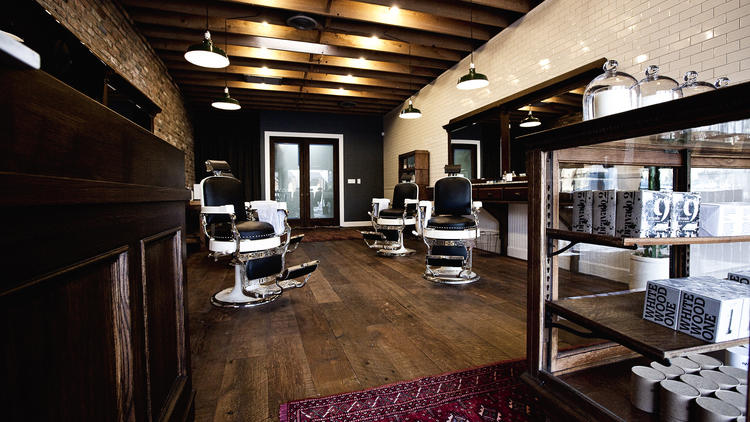
Ruffians Barbers, London
Ruffians Barbers has multiple outlets across London and Edinburgh, all of which showcase excellent lighting design.
In their Covent Garden shop, they’ve used a mix of vintage-style pendant lights and modern spotlights to create a dynamic lighting design. The pendant lights, which hang over the barber chairs, provide focused task lighting, while the spotlights create a bright, even ambient light.
Again, large windows play a significant role in their design, allowing plenty of natural light into the shop during the daytime. They’ve also included mirror lighting, which not only helps the barbers with their work but also enhances the customer experience by providing better visibility.
Ruffians have also paid attention to the color temperature of their lighting. They’ve opted for a neutral to cool white light, which provides an accurate reflection of hair color and complements their clean, modern aesthetic.
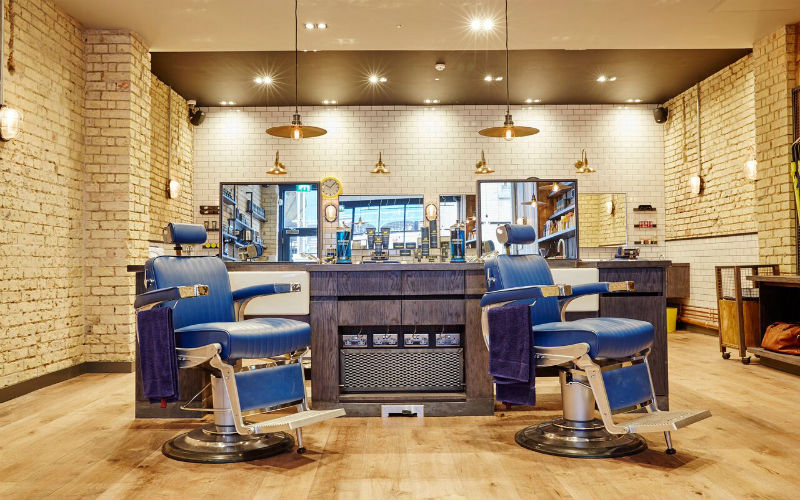
These two examples demonstrate how effective lighting design can enhance both the functionality of a barber shop and the overall customer experience. They showcase the importance of considering task lighting, ambient lighting, natural light, and color temperature in your lighting design.
Conclusion: Lighting Your Path to Success
Lighting is one of the key factors in creating a successful barbershop environment. A well-lit space not only supports the precision and care in a barber’s work, but also sets the mood and the experience for the customer, from the moment they step through the door until they leave with a new look.
Having a variety of lighting, including task lighting for precision work, ambient lighting for general illumination, and accent lighting to highlight features and products, can create a dynamic and appealing space. Additionally, using natural light and considering color temperature can further enhance the atmosphere and functionality of the shop.
However, it’s not just about aesthetics and functionality. Energy efficiency and compliance with lighting regulations are also important considerations. This not only demonstrates a commitment to sustainability and social responsibility but can also result in cost savings over time.
Ultimately, good lighting design is about understanding and balancing these various factors to create a space that works for both the barbers and the customers. It’s about creating an environment that feels professional, welcoming, and comfortable—a place where customers will want to return time and time again.
Mastering the art of lighting in your barbershop can indeed light your path to success. With careful consideration and planning, your shop’s lighting can enhance your services, showcase your professionalism, and provide a welcoming environment that will keep customers coming back.
Sinolumi LED Ltd. Provides Best Luminaire For Barber Shops
As a leading manufacturer of LED lights in the market, we at Sinolumi LED Ltd. use top-quality materials and the latest technology in our high-tech manufacturing plants to create the best lighting products.
We have an extensive catalog of both indoor and outdoor LED lights, including recessed, panel, track, and spotlights. Our products excel in quality and aesthetics, meeting high international standards assured by our expert team. Despite not compromising on quality, our products are competitively priced in the market.
But that’s not all! We provide 24/7 customer service to help you customize your orders, promising success for your venture. So, don’t wait, contact us NOW!
